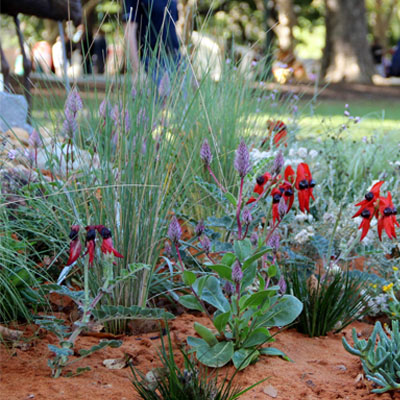
Dry loving plants including the iconic Sturt's Desert Pea
The recent ten-year drought changed the way many Australians think about their gardens. The lush, evergreen garden styles that were bought over from Europe are no longer seen as sustainable – and new styles are cherishing the beauty (and resilience) of our fantastic Australian native plants.
It's now entirely possible - and even fashionable - to have a garden that can survive and thrive in the heat of the Australian summer. All that's needed is a little thought and planning.
Use dry-loving plants
Many plants will not only endure the dry – they love it! Dry-tolerant plants aren't just limited to tired grasses and hurtful cacti – there's a whole world of plants to consider.
First and foremost are the dutiful Australian natives. While some natives are a bit shy and retiring, there are many more with striking figures and colourful flowers. To add form, consider austrostipa, eucalyptus, or even a Brachychiton rupestris (Queensland Bottle Tree). For colourful flowers, check out what the acacia, banksia, and proteacea families have to offer.
If you're looking overseas for inspiration, try plants from the Mediterranean, Southern Western United States, or other similarly dry places.
A word of warning on selection and planting
It's easy to sing the virtues of dry-loving plants, but you need to be aware that not all dry-loving plants are the same. Some will tolerate the cold, others can handle wet periods and, strangely, some can cope with the dry but not the heat. Choose plants that are from a climate similar to your own.
Whatever their requirements once established, every plant needs help getting settled in too. Don't simply pop the plant into the ground and hope it'll be okay; for the first couple of months, ensure it gets enough water at the edge of its root circle to encourage the growth of new roots.
Contour the land to direct water
To make the most of the rain that does fall on your garden, contour the land to direct water into certain areas and then plant according. For example, you'll want the more dry-tolerant plants at the top of your 'hills', and those than need more water in the 'valleys'. The contours don't need to be large – less than 500mm will be fine.
Mulch, mulch and mulch some more
To prevent the soil from drying out, lay a protect covering of mulch over the top. It's estimated that the right mulch can reduce the need to water by as much as 60%.
The type of mulch you use will depend on your other gardening objectives. If you're looking to enrich the soil further, an organic mulch such as pea straw, lucerne, or bean is ideal. Another organic option is bark, which takes longer to break down. It adds less to the soil, but by the same token needs to be replaced less often.
For those looking for a low-maintenance option, inorganic mulches like stones, pebbles or scoria are best. Keep in mind that these are low – not no – maintenance options – they'll still need an occasional weed, even if you lay a weed suppressant mat underneath.
Water wisely
If and when you do need to water, do so wisely.
- Water at dawn or dusk (or better yet during the night) to avoid excessive evaporation from the heat or sunlight.
- Use a trickle irrigation system that slowly 'leaks' water onto the ground, giving the soil time to absorb the water and reducing runoff.
- Water containers by hand to ensure the water is directed exactly where it's needed and not onto the surrounding decking or paving.
Learn from your neighbours
There are an endless number of climate and soil combinations in Australia – what might grow in one place may not thrive in the next. Take a peek at your neighbours' gardens; any avid gardener will be happy to share what they've learnt – particular to someone admiring what they've created! Likewise, your local nursery will be full of good suggestions to help you create a hardy, drought-resistant garden.
Many botanic gardens are now creating areas displaying dry-loving and drought-resistant plants. The Australian Garden at the Royal Botanic Gardens in Cranbourne, Melbourne is particularly spectacular and offers an amazing example of what can be achieved with a small amount of water.